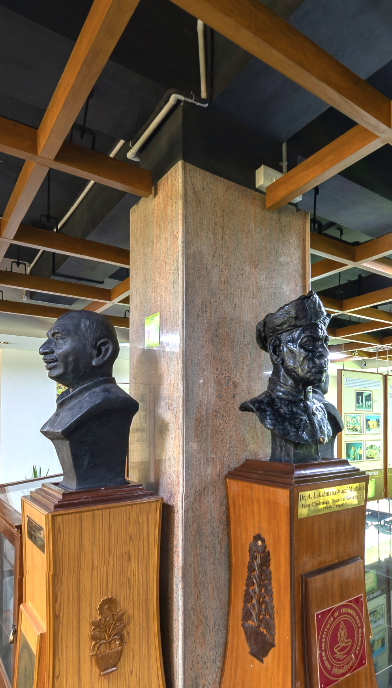Microwave Interferometer
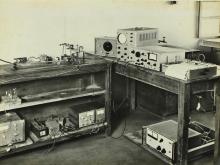
- Photographs , Equipment , 1970s
Seen in the image is a 4mm microwave interferometer for the measurement of dielectric constant and loss tangent of liquids. The equipment was photographed at the department of physics. The main feature of this set up is that the standing wave pattern in the liquid can be directly recorded on an X-Y chart recorder. The sample cell was designed such that the dielectric parameters could be determined as a function of temperature. Facilities were also included for the measurement of dielectric constant and loss for liquids as well as solids at higher wavelengths. Similar photographs can be…
Air Heater
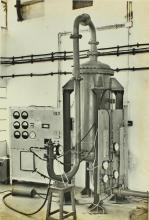
- Photographs , Equipment , 1970s
The Air heater in the image is of the Pebble Bed type and was designed to supply heated air to the Supersonic Combustion Test Facility. It also served as a model heater for a larger heater developed for the hypersonic wind tunnel at the Vikram Sarabhai Space Centre (VSSC), Trivandrum. It can supply air at the rate of 0.2 kgm per second at maximum air temperature of 350° C. The equipment was photographed at the Department of Aeronautical Engineering, IIT Madras. Similar photographs can be found in album 0334: 001/0334/IMG_105798 & 001/0334/IMG_105804
Microwave parabolic antenna
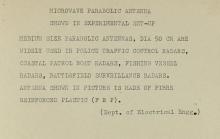
- Photographs , Equipment , 1970s
The text in the image defines the uses of microwave parabolic antennas. Medium size parabolic antennas (50 cms diameter) are widely used in police traffic control radars, coastal patrol boat radars, fishing vessel radars and battlefield surveillance radars. The image also states that an antenna was made using Fibre Reinforced Plastic (FRP) by the FRP Centre at IIT Madras. The Composite Structures (FRP) Research Centre, also known as the Fibre Reinforced Plastics (FRP) Centre was started at IIT Madras in March 1974. It was started due to the increased use of FRP, on a global scale, for…
Photo-resist spinner

- Photographs , Equipment , 1970s
The image describes a photo-resist spinner designed by the Department of Electrical Engineering, IIT Madras. This equipment was specially designed and developed for applying thin and uniform coating of a photo-resist material on various substrates. It is intended for applications in the R and D and manufacture of semi-conductor devices like transistors, diodes, I.Cs and thin film devices. It can also be used for coating thin layers of any other liquid material. Similar photographs can be found in album 0329: 001/0329/IMG_105828 & 001/0329/IMG_105836
Linear disc motor
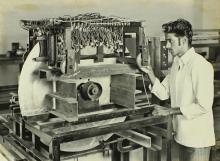
- Photographs , Equipment , 1970s
Seen in the image is a linear disc motor that was made by the Department of Electrical Engineering at IIT Madras. A linear induction motor is a device which can produce thrust along a straight line without the help of a crank or lever arrangement for converting rotary motion to linear motion. The main applications of such a motor can be seen in the doors of lifts, high-speed ground transportation, low speed belt conveyors and impeller drives without a separate motor. The person seen in the image is yet to be identified. A similar image can be found in album 0329: 001/0329/IMG_105827
Burst Pressure Test on filament wound shell
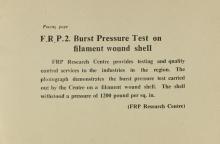
- Photographs , Equipment , 1970s
IIT Madras set up six centres in the year 1973. The Composite Structures (FRP) Research Centre, also known as the Fibre Reinforced Plastics (FRP) Centre, was one of them. The Centre was officially opened in March 1974 and it aimed at co-ordinating and utilising its expertise and resources to advance the special areas of technology that was of national importance. It also aimed at providing technical advice and leadership to the FRP industry in the country. The key objectives of the Centre and services offered included: Research and development of raw materials and composites, process design…
Hydraulic vibration machine
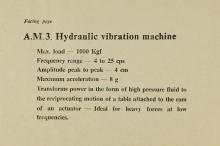
- Photographs , Equipment , 1970s
A hydraulic vibration machine transforms power in the form of high pressure fluid to the reciprocating motion of a table attached to the ram of the actuator. The hydraulic vibration machine described in the image has the following specifications: Maximum load – 1000 kgf, Frequency range – 4 to 25 cps, Amplitude peak to peak – 4 cm and Maximum acceleration – 8 g
Accelerated testing of reinforcement in concrete
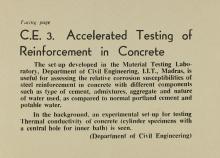
- Photographs , Equipment , 1970s
The image describes a set-up that was developed in the Material Testing Laboratory, Department of Civil Engineering, IIT Madras. The set-up was used for assessing the relative corrosion susceptibilities of steel reinforcement in concrete with different components such as cementitious material, admixtures and aggregates.
Myoelectric Trainer
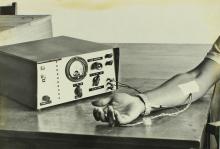
- Photographs , Equipment , 1970s
Myoelectric trainers are devices that help in the rehabilitation of amputees. The myoelectric trainer seen in the image was developed in June 1975 by the Biomedical Engineering Division at IIT Madras. The described device is useful for assessing the remnant muscle activity of the amputee and for training him to produce various levels of EMG.
Filament wound tubes under test
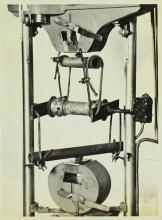
- Photographs , Equipment , 1970s
IIT Madras set up six centres in the year 1973. The Composite Structures (FRP) Research Centre, also known as the Fibre Reinforced Plastics (FRP) Centre, was one of them. The Centre was officially opened in March 1974 and it aimed at co-ordinating and utilising its expertise and resources to advance the special areas of technology that was of national importance. It also aimed at providing technical advice and leadership to the FRP industry in the country. The key objectives of the Centre and services offered included: Research and development of raw materials and composites, process design…
Pattern generator
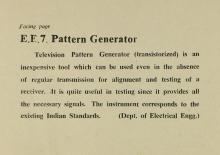
- Photographs , Equipment , 1970s
The image provides information about a pattern generator that was developed by the Department of Electrical Engineering in IIT Madras. A television pattern generator (transistorized) is an inexpensive tool which can be used even in the absence of regular transmission for alignment and testing of a receiver.
Model of a hyperbolic Paraboloidal shell footing (outside view)
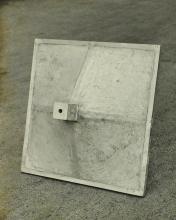
- Photographs , Equipment , 1970s
The image depicts a model of a hyperbolic paraboloidal shell footing that was designed by the Department of Civil Engineering at IIT Madras. Hyperbolic paraboloidal shell footings are economic alternatives to plain footings in situations involving heavy column loads and weak soils. These footings are developed as precast foundations and installed using a special technique. Precast shell footings installed in this manner are particularly advantageous for industrial structures.
Ninth standard children in Kendriya Vidyalaya (IIT Campus) learn computer programming

- Photographs , Equipment , 1970s
The image describes students (9th standard) learning Computer Programming at Kendriya Vidyalaya. The Kendriya Vidyalaya School is within the IIT Madras campus. It is possible that the students were photographed during a visit to the Computer Centre that is part of the campus. The Institute’s Computer Centre was inaugurated on 17th November 1973. Similar photographs are found in album 0330: 001/0330/IMG_105839, 001/0330/IMG_105844 & 001/0330/IMG_105846
Hyperbolic paraboloidal shell footing
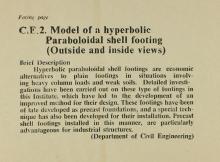
- Photographs , Equipment , 1970s
The image describes a model of a hyperbolic paraboloidal shell footing that was designed by the Department of Civil Engineering at IIT Madras. Hyperbolic paraboloidal shell footings are economic alternatives to plain footings in situations involving heavy column loads and weak soils. These footings are developed as precast foundations and installed using a special technique. Precast shell footings installed in this manner are particularly advantageous for industrial structures.
Filament wound tubes under test
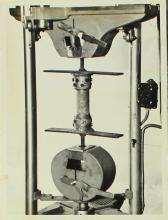
- Photographs , Equipment , 1970s
IIT Madras set up six centres in the year 1973. The Composite Structures (FRP) Research Centre, also known as the Fibre Reinforced Plastics (FRP) Centre, was one of them. The Centre was officially opened in March 1974 and it aimed at co-ordinating and utilising its expertise and resources to advance the special areas of technology that was of national importance. It also aimed at providing technical advice and leadership to the FRP industry in the country. The key objectives of the Centre and services offered included: Research and development of raw materials and composites, process design…
- Contribute
to the Centre -
Monetary
Support - Digital
Material

